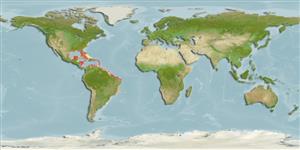Common names from other countries
Environment: milieu / climate zone / depth range / distribution range
Écologie
; profondeur 6 - 20 m (Ref. 104365). Tropical
Distribution
Pays | Zones FAO | Écosystèmes | Occurrences | Introductions
Western Atlantic: USA to Brazil.
Length at first maturity / Taille / Poids / Âge
Maturity: Lm ? range ? - ? cmCommon length : 6.5 cm TL mâle / non sexé; (Ref. 344)
Description synthétique
Morphologie
Shell wedge-shaped, heavy, moderately inflated, with rhomboidal outline. Shell surface smooth. Posterodorsal slope somewhat flat. Pallial sinus large. Hinge with 2 lateral teeth (1 bifid) on each valve, lateral teeth absent. Umbones slightly posterior. Periostracum thin, glossy. Colour: tan cream with purple umbonal region; periostracum brown (Ref. 344).
It has a total length of 6.5 cm (Ref. 344). Combination depth range: min from literature, max from estimate. It is found infaunal in shallow sandy bottoms (Ref. 344). Infaunal (Ref. 104365).
Life cycle and mating behavior
Maturité | Reproduction | Frai | Œufs | Fécondité | Larves
Members of the class Bivalvia are mostly gonochoric, some are protandric hermaphrodites. Life cycle: Embryos develop into free-swimming trocophore larvae, succeeded by the bivalve veliger, resembling a miniature clam.
Leal, J.H. 2003. (Ref. 344)
Statut dans la liste rouge de l'IUCN (Ref. 130435)
statut CITES (Ref. 108899)
Not Evaluated
Not Evaluated
Utilisations par l'homme
Pêcheries: commercial
| FishSource |
Outils
Plus d'informations
Taille/ÂgeCroissanceLongueur-poidsLongueur-longueurMorphologieLarvesAbondance
Sources Internet
Estimates based on models
Catégorie de prix
Unknown.
